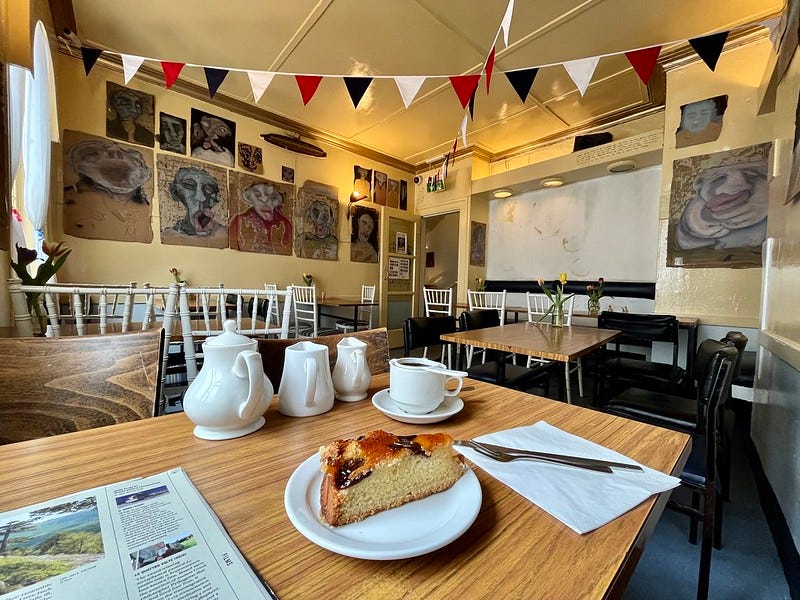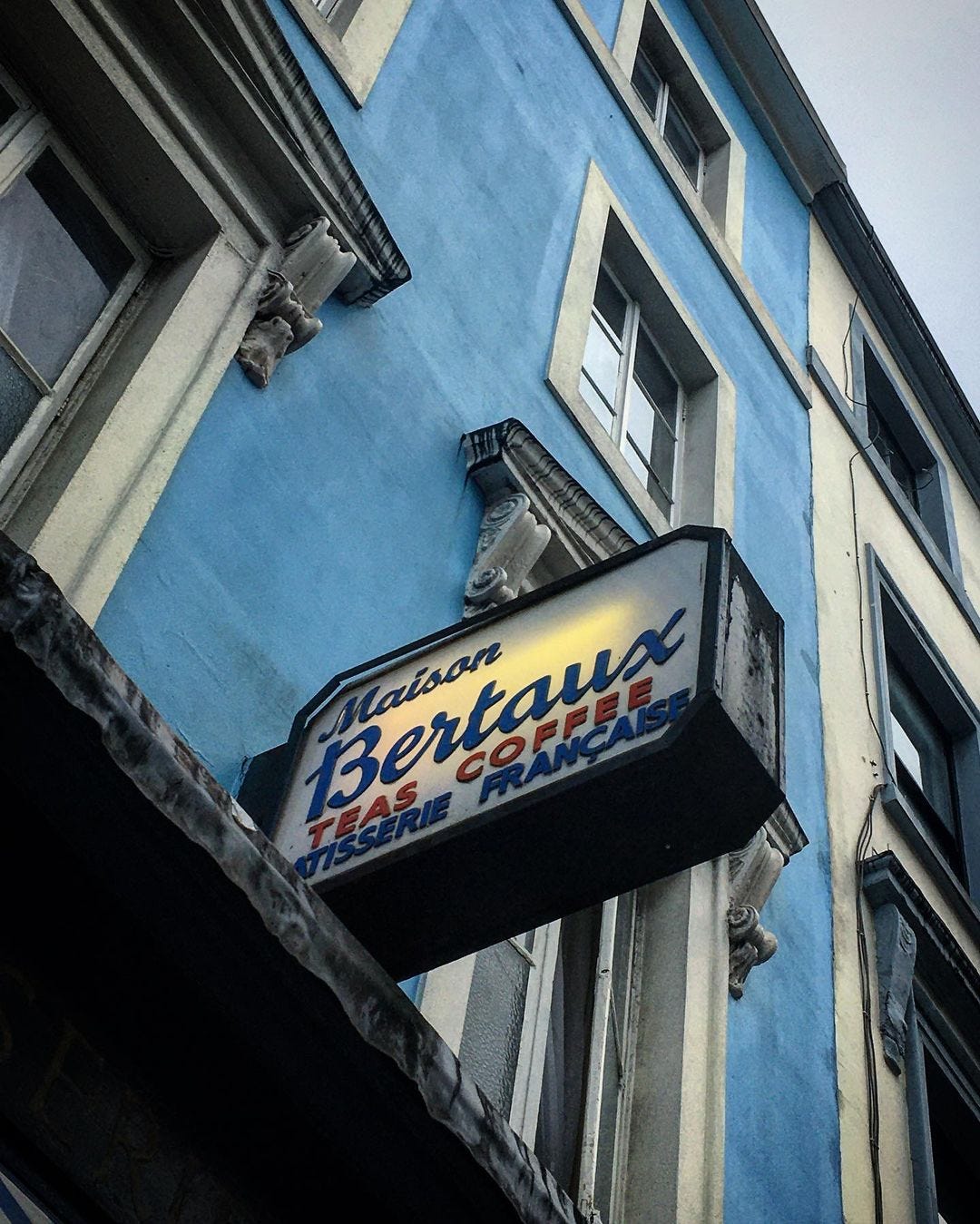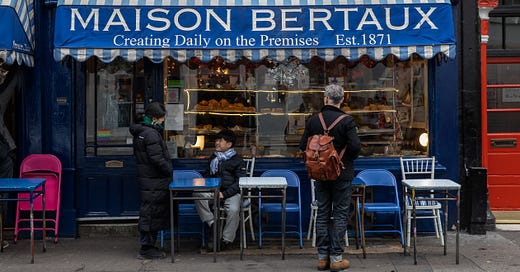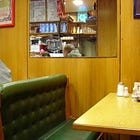Welcome to the second installment of ‘Before You Go’, our series where we invite someone we like and whose opinion we trust to pick one spot that they absolutely adore but that might be at greater risk at disappearing than it was a few years ago.
It might be a small family-owned restaurant, a backstreet pub, or a community garden… Any kind of place of which there are far fewer of these days. The idea is to go and visit the place with the person who nominated it and talk about what makes it so special: the people, the food, the drinks, the atmosphere, the decor and the history. In doing so, maybe we can tempt a few people to visit it for the first time or to go back and reacquaint themselves with an old favourite.
For this edition we're completing our accidental Soho trilogy with some French-inflected tea and scones on Greek Street (next month we’re going to south London, we promise).
Here are the first two instalments in case you missed them:
Maison Bertaux on Greek Street, with Phil Gyford
They say you can tell quite a lot about a person by whether they put the jam or cream on their scone first, so when the cakes arrive (along with a large pot of tea) at our table in the legendary Soho patisserie and tea room, I watch closely to see which way Phil Gyford decides to go.
I need all the clues I can get, because I’ve never actually met Phil ‘in real life’, and yet, I’ve been admiring and enjoying his work for over two decades now.
In 2002 Phil began a ten-year project to publish every entry from The Diary of Samuel Pepys online on the day they were first published. The digital version of Sam’s journal attracted well-deserved acclaim and even a few awards (including a Guardian Blog Award in 2003, alongside a London-centric site called The Big Smoker), and the site is now on its third go around and still finding new readers.
In the intervening two decades, Phil has lived in Clapham, Hackney and the Barbican; worked on digital projects for the likes of the BBC, The Guardian, the British Museum, MoMA and TheyWorkForYou; and most recently built the marvellous ooh.directory, a catalogue of blogs of all types.
He’s also the kind of person who puts the preserve on his scone before the dairy.
When I ask him why he explains that it’s a purely ‘structural’ decision. “You want to put lots of cream on top of the quite flat jam,” he says (please direct any correspondence about this towards Phil, and not us).
Immaculate imperfection
We’re upstairs in Maison Bertaux, in the hope that it may be a bit quieter and easier on the Dictaphone. But if you’ve ever been to this corner of Greek Street you’ll know that it’s rarely quiet here. This not really a place for gentle contemplation thanks to the almost-constant background clatter of crockery and cutlery, which ensures that all conversations have to go up a notch in volume. Then there’s the half-shouts of the staff echoing off the low ceilings as they call out instructions to each other and their customers.
It’s a very Soho kind of noise. The same joyous cacophony you might get in Coach & Horses right next door, or Bar Italia around the corner. The sound of a place that is genuinely ‘alive’ in every sense of the word. It’s a sign of imperfection and inefficiency; and we wouldn’t have it any other way.
“It’s about how the social and organisational aspects come to affect a place,” Phil says when I ask him what it is about Maison Bertaux in particular that makes it so special to him. “If we had gone somewhere new today it would have all been very efficient. Now that’s not to say that this place isn’t efficient exactly, but a new place wouldn’t start with the same processes or ways of delivering things. But because here is not new and sharp it just feels more relaxed somehow.”
It’s a strange paradox, that this noisy, crowded cake shop, with its small rooms, narrow staircase and uneven floors can feel more relaxing than the many sterile, whitewashed ‘third wave’ coffee shops to be found elsewhere in Soho. But it’s undoubtedly true and increasingly rare.
“Originally of course, everywhere worked like this,” Phil says, tucking into the second half of his structurally-sound scone, “but over time places become more and more digitised and they figure out how to run with half the number of staff, but they lose something else when that happens. On the way here, I had a mid-morning sandwich at Paul Rothe & Sons in Marylebone, which is somewhere else that has been around forever. The process there is you go and order from the sandwich counter and they make it for you by hand, and then you can go and sit down on the seats that look like they’ve been there for fifty years. The whole thing is great, but places that were just starting out wouldn’t do anything like that.”
Soul mates

Despite never working in Soho (the closest he ever came was his time in the late 90s, building websites for Capital Radio out of their Leicester Square HQ), Phil tells me that he has always been drawn to the area and still visits, even if it takes him out of his way. “I always find an excuse to make my walks come through here, because there’s always something to see,” he says. “It’s like walking through Smithfield first thing in the morning: if you do it on the right day then on one side of the road there’ll be people coming out of Fabric and on the other side there will be big lorries full of carcasses. Brilliant!
“I just like the size of Soho, the small streets and shops,” he continues. “In some ways, there’s a lot about this area that gets talked about by advocates of ‘walkable cities’. But it’s not like anyone is about to start building lots of new Sohos with tiny streets and little shops.”
In those heady Capital FM days Phil would spend most of his time here sampling the cafes and restaurants or combing through Soho’s record shops for second hand CDs, but it was a date that first brought Phil to Maison Bertaux.
“It was a Guardian Soulmates date” he laughs. “I’d never heard of this French bakery, but she suggested meeting here. To be fair, it was a better choice than one of my other dates, who chose Wong Kei. Which is a great place, just not necessarily for a first date!”
Talk of Wong Kei leads to a discussion on the politeness (or not) of staff in various Soho establishments (Norman’s of course being another prime example); and we both agree that, while there is zero rudeness in Maison Bertaux, there’s also a merciful lack of obsequiousness, which means everyone is treated the same whether they’re a regular Soho local, or a first-time tourist.
When I ask Phil what made him become a regular visitor to ‘London’s oldest patisserie’ he puts down of his cup of tea down and lets out a sigh. “I’ve been trying to think about why I like Maison Bertaux so much, and it’s difficult, because everything ends up sounding a bit obvious. But, in the end, I think it has something to do with the fact that it’s more and more difficult to find places that are truly unique. So many places open and, even if they’re not part of a chain, you look around and they look like they’re part of a chain.
“It probably also has something to do with the fact that none of those places are run by the people who own them” he continues. “Nobody working there has any investment in the place and it’s just a job. You can almost taste the private equity in them. Compare that to somewhere like this, where some of the people downstairs are also the people who own it and have been working here for a long, long time. I guess that’s what helps keep places like this open: they own the building. That’s the same with a lot of special places in London, like the umbrella shop near Tottenham Court Road - they can only still be around because they own the place.”
Carry on baking

As we mop up our scone crumbs the conversation inevitably turns to the changing face of Soho and what that means for the future of Maison Bertaux.
Keep reading with a 7-day free trial
Subscribe to London in Bits to keep reading this post and get 7 days of free access to the full post archives.






